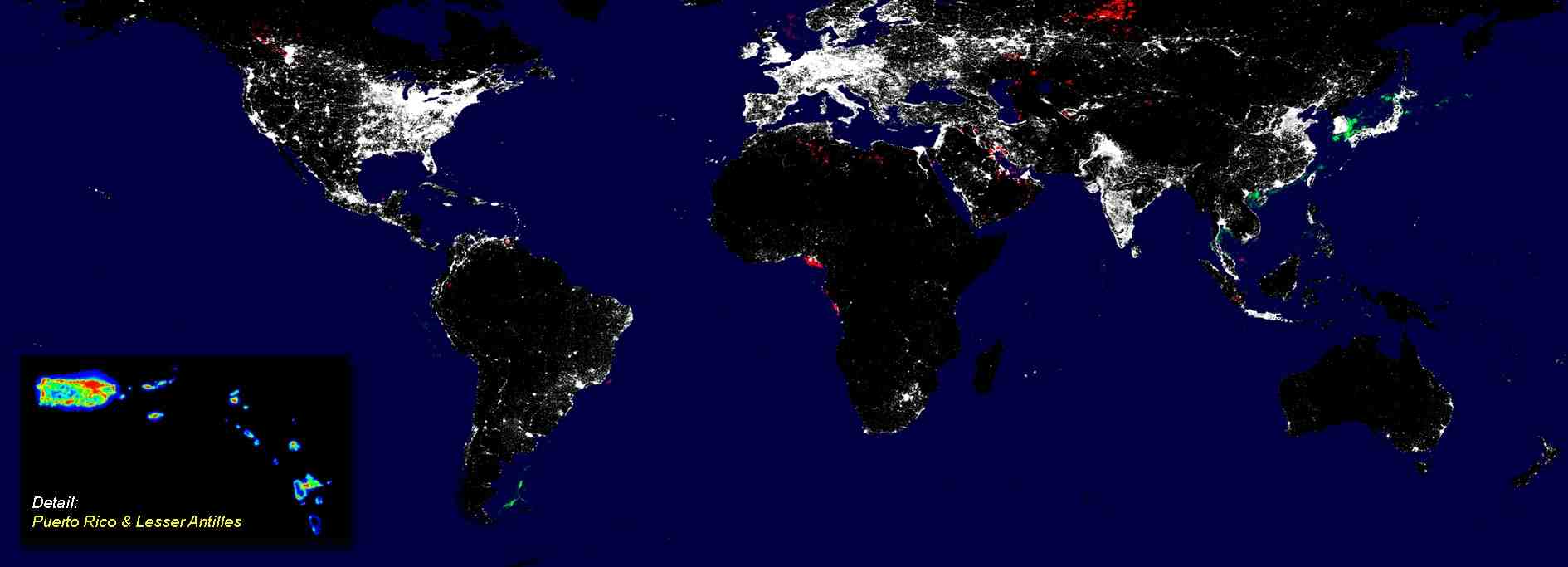 |
| Artificial nighttime lighting. Image courtesy of EarthZine, which also features an interesting article about the impacts of nocturnal light pollution. |
The study, conducted in a historical garden at the University of Exeter's Penryn Campus, found that shorter wavelength (whitish) lights attracted more moths than longer wavelength (yellowish) lights--especially when both types of light were broadcast simultaneously and moths had a choice between the two. This pattern was particularly strong for owlet moths (Noctuidae); geometer moths (Geometridae), on the other hand, were equally attracted to both short- and long-wave light. Both moth groups fall into the larger category of "macromoth," a set of species that have declined markedly in recent years.
Intriguingly, population decreases have been observed in nearly twice as many species of Noctuidae as Geometridae, suggesting that short-wave light pollution may have played an important part in the decline of these animals. For that to be confirmed, however, researchers will need to overlay maps of light pollution and moth decline and see whether the Noctuid decreases have been particularly noticeable in areas with shorter wavelength lighting.
 |
| A lesser broad-bordered yellow underwing, a.k.a. Noctua janthe. This is one of several noctuid species captured during the study. Image courtesy of Chris Harlow, via UK Moths. |
The relatively simple methods used in the current study suggest that this follow-up work will not be too difficult to accomplish. During the summer (June-October) of 2012, the researchers broadcasted light from lamp-post structures fitted with either longer wavelength or shorter wavelength bulbs; lights were turned on both independently (e.g., short wavelength or long wavelength only) and together (e.g., both wavelength types broadcast simultaneously). Each light was fitted with safari traps designed to capture moths attracted to the glow. In the morning, researchers examined their captives and identified each to the species level. In addition to performing analyses on overall moth abundance and diversity, the scientists also investigated data concentrating only on the two most abundant families (Noctuidae and Geometridae) and species (Ochropleura plecta, a geometrid, and Noctua janthe, a noctuid).
While it may be easy to construct artificial light treatments, it may not be so simple to determine the mechanisms driving insect responses to the illumination. Both physiology and morphology (among other things) are likely to play important roles in light attraction: Moths are probably most attracted to the wavelengths to which their eyes are most sensitive, while their locomotion skills may help determine whether the animals are able to successfully wing their way towards the bulbs.
 |
| Flam shoulder, a.k.a. Ochropleura plecta, the geometrid most commonly caught during the current study. Image courtesy of Ian Kimber, via UK Moths. |
Thus, researchers will probably need to take moths into the laboratory in order to collect data on these and other species-specific characteristics. It's unlikely that they will be able to study these traits in all 61 British macromoths that have recently experienced declines. However, careful selection of a few representative species may yield important findings that can illuminate a path towards improved management practices beneficial to these declining insects.
---
Somers-Yeates, R., Hodgson, D., McGregor, P.K., Spalding, A., and ffrench-Constant, R. 2013. Shedding light on moths: shorter wavelengths attract noctuids more than geometrids. Biology Letters 9(4): online advance publication.
This post is very nice . custom essay writing service will be provided this papers are newly created contents only all contents are fresh content.
ReplyDelete